C.P. Lesley's Blog, page 16
May 7, 2021
Interview with Emily Hourican
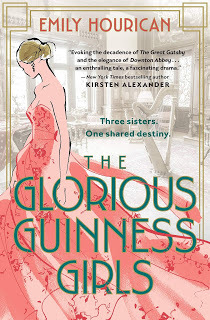 Even as a child growing up in the UK, I had heard of Guinness beer. I have vague memories of, at one point in my life (not as a child, obviously!), being advised to drink stout because of its iron content—a suggestion that went nowhere because I never developed a liking for stout. But the idea that a particular brand of beer must be the brain child of an individual with a vision, and that the individual in question might have a family worthy of a novel, never occurred to me until a publicist pitched Emily Hourican’s
The Glorious Guinness Girls
for a New Books Network interview that didn’t fit into my schedule. I read the book, enjoyed it, learned a lot about 1920s high society, and am delighted to have the opportunity to share with you this interview with the author. Read on to find out more, and don’t forget to admire that gorgeous cover, with its Guinness harp smack dab in the center!
Even as a child growing up in the UK, I had heard of Guinness beer. I have vague memories of, at one point in my life (not as a child, obviously!), being advised to drink stout because of its iron content—a suggestion that went nowhere because I never developed a liking for stout. But the idea that a particular brand of beer must be the brain child of an individual with a vision, and that the individual in question might have a family worthy of a novel, never occurred to me until a publicist pitched Emily Hourican’s
The Glorious Guinness Girls
for a New Books Network interview that didn’t fit into my schedule. I read the book, enjoyed it, learned a lot about 1920s high society, and am delighted to have the opportunity to share with you this interview with the author. Read on to find out more, and don’t forget to admire that gorgeous cover, with its Guinness harp smack dab in the center!This is not your first novel, but it is your first historical novel. What are the advantages and disadvantages of writing historical versus contemporary fiction, in your view?
Yes, I had written four contemporary novels before switching to historical fiction. I was ready for a change. I wanted to keep writing, but to write in a slightly different way. Historical fiction throws up certainties—boundaries—which make it very interesting from an imaginative perspective.
It was interesting to work within a factual framework. To have a skeleton structure that couldn’t be altered—dates of birth, of marriage, the significant events of the time, small dates such as when the Guinnesses were known to have attended a party or been in a certain place. Within that, then, the challenge was to fill out a story that didn’t alter the facts, that took account of them and worked together to create something.
So instead of contemporary fiction, in which the only limit is your imagination and the psychology of your characters, there were fixed points I couldn’t mess with. I loved that. It made it feel like a jigsaw puzzle with some bits complete, and I had to fill in the rest.
Disadvantages? The same thing, from a different perspective! Sometimes it would have been easier for the story if I had been able to move the girls around more freely, ignore the fact that they couldn’t have been in a certain place at a certain time, because history had already recorded them as being somewhere else, for example. But in general, I didn’t find those disadvantages to be significant at all. The fun was far more than the irritations!
Your main character—Felicity, known as Fliss—is not one of the Guinness girls of your title. Unlike them, she is also your creation. How would you characterize her, and how does she become part of the Guinness world?
Fliss is someone who would have been far more typical of her time (the Guinness girls were definitely not typical; they were too rich!). Fliss is the daughter of an impoverished Anglo-Irish family (basically, that meant a big house, a lot of land, and very little actual money; for a girl like Fliss, that meant very few prospects in a world in which she could only have married within a narrow social sphere, and so many young men had died in the Great War).
She goes to live with the Guinness girls, initially to do lessons and be company for the girls—that kind of thing happened often enough to girls like Fliss. Often, it wasn’t a particularly happy arrangement, but in Fliss’s case, it works out very well. She and the Guinness girls become very close, and she stays on living with them long past the schoolroom.
For me, Fliss is a way to see into the Guinnesses’ world from a new and fresh perspective. Aileen, Maureen, and Oonagh themselves couldn’t have understood the extraordinary privilege of their lives. I wanted somehow who could—who could look at the way they lived, and know how very much it was removed from any ordinary experience.
I could also, through Fliss, show a different kind of possibility and outcome for the young women of the 1920s. The Guinness girls all stuck with very traditional roles—they were wives, mothers, hostesses, and patrons rather than doers, makers, creators. At a time when careers, independence, and agency were suddenly more available to women than ever before, the Guinnesses chose not to pursue them.
With Fliss, I was able to show something of the alternate world—the path the Guinnesses didn’t take. I loved the freedom she allowed me to do this.
Fliss’s brother, Hugh, has a very different personality from his sister, as often happens with siblings. His role in the novel, although secondary, is crucial. What can you tell us about him and what he adds to your tale?
Hughie, for me, was many things. He was male and therefore had freedom, autonomy, agency, in a way that his sister, certainly as a young person, did not. He had an education. The property, such as it was, would go to him. He could move about the countryside freely in a way that she could not. There were women of Fliss’s social class who got involved in the struggle for Irish independence—but they were always older, and usually richer, than Fliss.
Hughie could get involved with the fight for Irish freedom, with the world of politics and revolution, and he could bring that with him into the much smaller world that Fliss and the Guinness girls inhabited.
It wouldn’t have been credible to involve these girls directly in the political and social upheaval going on around them, and yet they lived through it. They watched the burning of the Four Courts in Dublin city on June 30, 1922. They were witnesses, if not participants, to these extraordinary events in Irish history, and Hughie, for me, was a way to bring those events closer to them.
He was also, for me, some much-needed male energy in their world—and male energy always seems to change things within a group of women!
You’ve mentioned that Maureen is your favorite among the three Guinness daughters. What sets her apart from her sisters, Aileen and Oonagh, as far as you’re concerned?
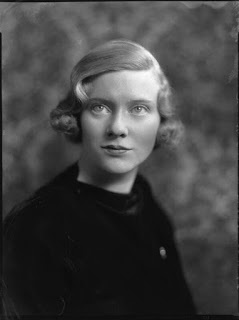
When I was researching this novel, I spoke to a wonderful man, also a writer, called Thomas Pakenham, who was a godson of Maureen’s. His father Frank was best man at Maureen’s wedding to Basil Blackwood. Thomas’s memories of Maureen are very vivid, and he recalls her as someone who was intelligent and very compelling, as well as very snobbish and self-centered. She had a strong personality and became monstrously self-centered and rude in later life. I was interested in the young Maureen—before she became like that. After all, no one is monstrous at ten, or sixteen, or twenty. She became a kind of caricature in later life, all diamond-studded cat-eyed sunglasses, blue hair, and vulgar practical jokes; I wanted to know what such a person was like before she became like that. I imagine she would have been charming, dynamic, entertaining, before she became too nasty and too selfish.
When the four girls—the Guinness sisters and Fliss—get to London, it’s the early 1920s. They encounter two separate social worlds: high society and the Bright Young Things. Could you sketch this environment, and the girls’ reactions to it, for us?
The 1920s were a fascinating point in UK society. The Great War, which ended in 1918, changed everything and accelerated social upheaval. Women had known a taste of freedom—working, nursing, seizing opportunities as they came—and were unwilling to go back. Meanwhile young people were sick of gloom and death and misery and determined to enjoy themselves. Many were also determined to forget the niggling guilt of not having fought in the War to End All Wars because they were too young. Many had lost fathers, brothers, cousins, and so on. They were driven by unacknowledged grief and a sense that life was short.
The result was an explosion of energy—cocktails, jazz, short skirts, fancy dress—that tore up the old, decorous rule book around what could and couldn’t be done. Girls got their hair cut, got drunk, and went wild. Older society matrons were horrified. The newspapers were delighted—they had endless parties and scandals to write about. It was a period of manic energy that expressed itself in parties and frivolity until the Great Crash of 1929 brought it to an abrupt end.
The Guinness girls were a big part of this 1920s scene. There was even something called The Guinness Set that revolved around their cousin Bryan, his wife Diana Mitford, and the Guinness girls. They were the giddiest, showiest, and richest of all the showy and giddy scene.
Despite years of living in luxury, albeit as a kind of glorified servant or charity case, Fliss ultimately chooses to pursue a career rather than, say, marry for money. Why did you include this element in your novel?
I became very fond of Fliss as I wrote this book. She is a truly generous and kindly person, and the idea of abandoning her to a fate like Gunnie’s, in which she is a companion and subordinate for her entire life—I just couldn’t do it! Neither did I want her to switch from one kind of servitude—with the Guinnesses—straight into another kind, which would have been marriage in those days. I wanted Fliss to make good on all her subtle intelligence and decency and choose a life for herself that allowed her to become a person of substance in her own right.
I also wanted her to demonstrate, through her choice, the interesting (to me!) fact that the Guinness girls did not make that kind of choice. A path diverged for women in the early 1920s, and Fliss chose what I believe was the more dynamic route.
Are you already working on something new?
I am! I am deep into writing the second book in the series. It’s called The Glorious Guinness Girls: A Hint of Scandal, and it follows the girls’ lives through the very troubled 1930s, when they are wives and mothers and encounter personal difficulties at the same time as Europe is moving toward the Second World War.
Thank you so much for answering my questions!
Thank you so much for asking me!

Emily Hourican is the author of four contemporary novels and The Glorious Guinness Girls, nominated for the Best Popular Fiction Awards at the 2020 Irish Book Awards. A former editor and journalist, she lives in Dublin with her husband and children. Find out more about her at https://www.emilyhourican.com.
Photograph of Maureen Guinness (1933) by Bassano, public domain through Wikimedia Commons.
April 30, 2021
Someone Else's Universe
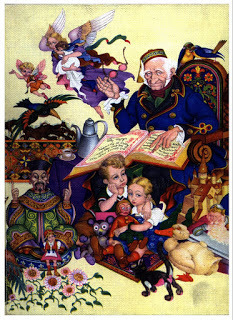 Fan fiction has something of a bad rep in the writing and reviewing community. People wonder: Could you not come up with your own ideas? Why borrow someone else’s creative universe?
Fan fiction has something of a bad rep in the writing and reviewing community. People wonder: Could you not come up with your own ideas? Why borrow someone else’s creative universe?At the same time, the publishing industry loves a certain kind of fan fiction. How else can we explain the endless progression of novels featuring the various Jane Austen heroines, Sherlock Holmes, and fairy tales? The larger the publisher, the more dependent it is on titles that will sell in the millions, not the hundreds, and the more attracted its editors are by the “sure thing.”
But the part that often gets lost is what writing (as distinct from publishing) fan fiction can do for an author just getting started. My first novel—excruciatingly bad as only the first drafts of a first novel can be and never published because of copyright constraints—was based on a Star Trek story I had told to myself for years. Not exactly an original story, because it could be classified as part of a category stuffed to the gills by other aspiring fan fiction writers, but all mine in its particulars.
I learned a lot while laying down that execrable prose, and more as I crafted it into better versions of the same, then rewrote it from scratch (more than once) while transitioning it to a new book set in a world of my own creation. Even then, I let it sit for almost two decades before giving it one more thorough overhaul and allowing Five Directions Press to publish it with every trace of the original, borrowed universe removed.
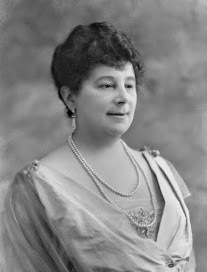 My second novel, the first to see the light of day, is an even more explicit example of fan fiction, evident in the title: The Not Exactly Scarlet Pimpernel. Again, it originated in a reworking of Baroness Orczy’s classic tale that I amused myself with at odd moments, then wrote down—only to realize that by resolving the original conflict I had run out of story within fifty pages. I learned a lot from that, too, and because The Scarlet Pimpernel was published in 1905 and is thus in the public domain, I was able to bring out my version with explicit acknowledgment of and thanks to Baroness Emmuska Orczy (less than 30 percent of the finished novel draws on her original, blended with a BBC production based on her work).
My second novel, the first to see the light of day, is an even more explicit example of fan fiction, evident in the title: The Not Exactly Scarlet Pimpernel. Again, it originated in a reworking of Baroness Orczy’s classic tale that I amused myself with at odd moments, then wrote down—only to realize that by resolving the original conflict I had run out of story within fifty pages. I learned a lot from that, too, and because The Scarlet Pimpernel was published in 1905 and is thus in the public domain, I was able to bring out my version with explicit acknowledgment of and thanks to Baroness Emmuska Orczy (less than 30 percent of the finished novel draws on her original, blended with a BBC production based on her work). Even before I finished The Not Exactly Scarlet Pimpernel, I had abandoned fan fiction entirely and moved into my own Russian-inflected historical world, now represented by eight novels in print and two more in the works. But the point is that I would never have written any of them had I not decided on that long-ago summer day to type out one scene from my highly unprofessional Star Trek story to ensure that I didn’t forget exactly how I wanted it to go.
So if you have a great idea for the perfect solution to Marianne Dashwood’s romantic problems, don’t hesitate. Writing is not the same as publishing (although if you can land a publishing contract, more power to you), and in the beginning it’s best not to get caught up in fantasies of publication anyway—first books are seldom good enough right off the bat. But writing fan fiction beats not writing at all. And I can promise you, even by roaming around in someone else’s creative universe, you can learn a lot about what it takes to bring your own to life.
Images: Old man surrounded by imaginary beings purchased on subscription from Clipart, no. 314581; photograph of Baroness Emmuska Orczy (1920), public domain via Wikimedia Commons.
April 23, 2021
Agony Aunt for the Ages
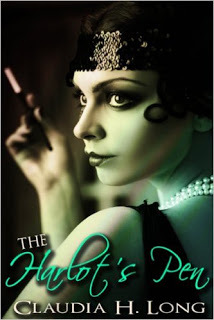 As someone who’s kept a weekly blog for coming up on nine years without interruption, I’m always looking for good ideas for the next post. The New Books Network interviews help fill the void, as do the increasing number of written Q&As that I host for authors I can’t fit into my podcast schedule. I have bookshelf lists once a quarter, updates on my own books or comments on the craft in general, discussions of historical research and its place in fiction, and occasional posts about individual books or series that I enjoyed.
As someone who’s kept a weekly blog for coming up on nine years without interruption, I’m always looking for good ideas for the next post. The New Books Network interviews help fill the void, as do the increasing number of written Q&As that I host for authors I can’t fit into my podcast schedule. I have bookshelf lists once a quarter, updates on my own books or comments on the craft in general, discussions of historical research and its place in fiction, and occasional posts about individual books or series that I enjoyed.
Even so, there are some weeks when I wake up on Thursday morning desperate for good ideas. I wish I had thought of this one, but the credit goes to my friend and fellow Five Directions Press member Claudia Long, who has created a time-traveling advice columnist willing to read and answer questions from fictional characters. Meet Madam Mariana.
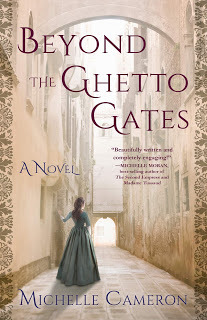 So, what kind of questions does Madam Mariana field? Not surprisingly, the first two in the series (it only started a few weeks ago, so this is definitely one to revisit—and worth signing up for the author’s updates) address issues raised by characters in Claudia Long’s own books. Another Mariana from a work in progress, fifteen and living in Cuidad de Mexico in 1586, seeks advice on how to deflect her mother’s marriage plans. A widowed journalist in San Francisco, heroine of Long’s
The Harlot’s Pen
, wants justification for her pursuit of an artist in 1933—and writes back two weeks later revealing that perhaps she’s not a widow after all.
So, what kind of questions does Madam Mariana field? Not surprisingly, the first two in the series (it only started a few weeks ago, so this is definitely one to revisit—and worth signing up for the author’s updates) address issues raised by characters in Claudia Long’s own books. Another Mariana from a work in progress, fifteen and living in Cuidad de Mexico in 1586, seeks advice on how to deflect her mother’s marriage plans. A widowed journalist in San Francisco, heroine of Long’s
The Harlot’s Pen
, wants justification for her pursuit of an artist in 1933—and writes back two weeks later revealing that perhaps she’s not a widow after all. Most recently, a young woman in Ancona, Italy, at the turn of the eighteenth and nineteenth centuries (Mirelle, the heroine of Beyond the Ghetto Gates, by Michelle Cameron, whom I interviewed for New Books in Historical Fiction last year) has watched the man she loves head off for Egypt with Napoleon’s army and fears he may never return. Like Lucy of The Harlot’s Pen, Mirelle gets into a back-and-forth with Madam Mariana. It’s all tremendous fun, as well as a convenient way to find out about titles you might like to add to your reading list.
And yes, Darya Sheremeteva, heroine of Song of the Sisters (2021), will be seeking advice a couple of Thursdays from now. So if you don’t check before then (and you certainly should), do go to the blog on May 6. I don’t know what Madam Mariana will say, but I suspect that Darya may be quite shocked at the advice she receives!
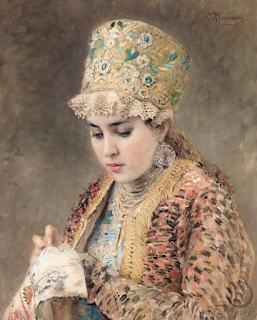
Image: Konstantin Makovsky, Noblewoman Stitching (1890s). Public domain because the artist died in 1915.
April 16, 2021
Stepping Back in Time
There’s a reason why most of my novels so far have featured aristocrats and even royalty. We may not know much about the day-to-day lives of Russian nobles in the fifteenth and sixteenth centuries—especially the women—but a few sources that track their doings and even their marriages have survived. There are annals, religiously and politically biased but somewhat reliable in terms of dates and sequences. And there are official records, scarce in 1400 and even 1500 but becoming more extensive as the central government slowly develops a basic structure, including offices devoted to foreign affairs and military musters and other aristocratic (male) pursuits.
Some of those sources also mention, if only in passing, the small number of men who staffed the government offices—men like Anfim Fadeyev, who first appeared in my books as a suitor for Grusha’s hand in Song of the Shaman and reappears as a secondary character and almost-friend of Darya in Song of the Sisters. Anfim will be back as the hero of Song of the Sinner, the next installment in the Songs of Steppe & Forest series, and will continue to lurk in the background of future books.
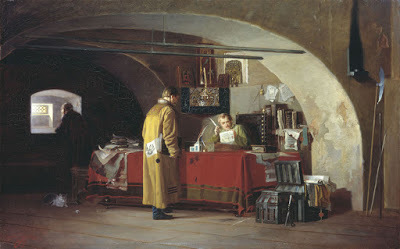
So far, so good. But step down one rung on the social ladder to merchants—even splashy international appointed-by-the-tsar, top-of-the-tier gosti (the word also means “guest”)—and you might as well take a nose dive off a cliff. Even the scholars who spend years of their lives studying merchants and trade in Muscovite Russia tend to focus on the seventeenth century, where they may not have much information to work with but they at least have some, or on the influx of English, Dutch, and German traders who left records that didn’t get burned up every time Moscow caught on fire, which happened every 20–30 years.
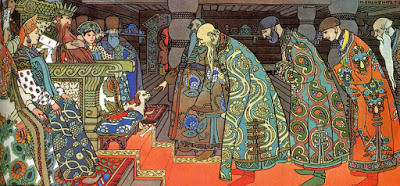
Can we extrapolate back from the seventeenth century to the sixteenth? To a degree, I’m sure we can. In a time before computers, television, radio, and public education, when information on how to live passed directly from father to son and mother to daughter, change happened more slowly.
But it did happen. The government consolidation I mentioned above got off to a slow start but mushroomed under the Romanov dynasty (1613–1917), and that development affected commerce as much as anything else. The arrival of the Muscovy Company in 1553–54 introduced new ideas and new ways of doing things. Russia’s conquest of Kazan to its east in 1552 and Astrakhan, near the Caspian Sea, in 1556 opened up a direct if still dangerous route from Moscow to the Silk Roads even as it angered the Ottoman Empire, a development that eventually imperiled the traditional trade route across the steppe to the Black Sea ports of Caffa and Surozh. And we haven’t even gotten to the fifteen-year civil war known as the Time of Troubles (1598–1613), which caused a general upheaval that swept up merchants along with peasants, nobles, and the dynasty itself. None of that had yet occurred in the 1540s, where the next few books in my series are set.
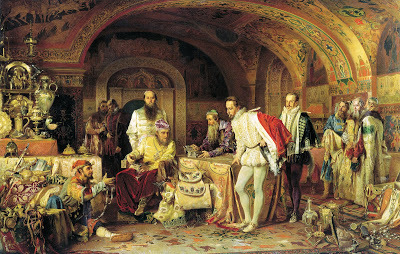
And that poses a challenge, because Anfim comes from a merchant family, and his brothers engage in commerce with both east and west. What that means for their everyday lives, their view of the world and their place in it, and their attitudes toward all kinds of things, I have to either find out or imagine. At moments like this, I wish I could book a seat on a time machine, even for a few hours, and observe firsthand the many details that bring fiction to life but don’t appear in the records. I’d love to buttonhole one of those Surozh silk traders and pepper him with questions or watch him from behind a screen as he talks to his family and his colleagues, then goes about his daily chores.
Fortunately, novelists—unlike historians—only have to give it their best shot before taking a chance, filling in the gaps of what is not recorded, and hoping that the results are somewhere close to the truth. Even so, to the historian in me the thought of that time machine is awfully tempting....
Images: Alexander Yanov, A Chancery in Moscow (1880s); Ivan Bilibin, Gosti, illustration from The Tale of Tsar Saltan (1905); Alexander Litvichenko, Ivan the Terrible Shows His Treasures to the Englishman Jerome Horsey (1875)—all public domain because of their age, via Wikimedia Commons.
April 9, 2021
World Conquest, Take Two
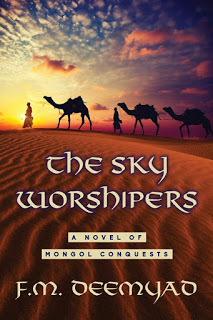 As a historian of medieval Russia, I have often encountered portrayals of the Mongol Conquest as an unmitigated disaster, a break in continuity vast areas of steppe and forest. This perspective—never so prevalent in the West, which endured brief invasions and climactic battles but not centuries of domination, assimilation, and coexistence—has been modified in recent years as scholars have moderated their views of both Russian history and the Mongol impact on the lands they conquered. Outside the realm of academe, however, it remains as prevalent as ever.
As a historian of medieval Russia, I have often encountered portrayals of the Mongol Conquest as an unmitigated disaster, a break in continuity vast areas of steppe and forest. This perspective—never so prevalent in the West, which endured brief invasions and climactic battles but not centuries of domination, assimilation, and coexistence—has been modified in recent years as scholars have moderated their views of both Russian history and the Mongol impact on the lands they conquered. Outside the realm of academe, however, it remains as prevalent as ever.But a question less often asked is the effect of the conquests on the Mongols themselves. What happened as a result of the influx of foreign cultures and religions imported by artisans, slaves, and concubines? How did the women captured by khans and beys influence the sons and daughters they bore?
That is the focus of my latest New Books Network interview with F.M. Deemyad, whose debut novel, The Sky Worshipers, appeared last month with History through Fiction. Through the overlapping stories of three stolen princesses—Chinese, Persian, and Polish—she traces the history of the conquest over three generations and charts the gradual shifts in the approach taken by Mongol khans toward the cities and civilizations they conquered. From the lives of these fictional women, we gain a unique perspective on a segment of world history that is too often oversimplified or ignored.
As always, the rest of this post comes from New Books in Historical Fiction.
There have been more than a few contenders for the title of “World Conqueror,” but eight hundred years after the fact, Genghis Khan’s claim to the title remains unmatched. Over the course of four decades, he and his heirs built a realm that stretched from the Korean Peninsula to the plains of Hungary and from northern Siberia to India. And unlike the conquests of Hitler and Bonaparte, the charismatic authority of Genghis Khan endured long after the initial union fractured into warring khanates.
Tackling even the establishment period of such a massive undertaking within the covers of a single historical novel poses a challenge for any author. In The Sky Worshipers (History through Fiction, 2021), F.M. Deemyad approaches the problem by focusing on three foreign princesses, captured in different places (northern China, Central Asia, and Poland) by Genghis, his son Ogodei, and his grandson Hulagu. These three women, each for her own reasons, together create a secret eyewitness account of the Mongol rise and expansion.
The female perspective allows Deemyad to avoid extended discussion of wartime atrocities and focus on the human cost of conquest and battles. Yet the atrocities are there too, reflected in the permanent scars left on survivors who must deal with disruption and loss even as they struggle to avoid being coopted into a world they neither created nor chose. In often haunting prose, Deemyad brings to life a slice of the past that, although not forgotten, has receded from view, obscured by the more recent disasters and tragedies of the twentieth century.
April 2, 2021
Bookshelf, Spring 2021
Yes, I know, it’s only six weeks since the last bookshelf post. But with the pandemic dragging on and spring finally on the horizon, I have lots of time to read and a new reason to record the latest set of books.
As you’ll see, for some reason I’ve been reading a lot of historical murder mysteries lately. But despite varying degrees of gore, none of these books is only a puzzle about who killed whom. What makes them memorable is a combination of richly envisioned historical settings, complex characters, and stories that have more to do with tangled networks of interpersonal connections than the specific circumstances that lead one person—sometimes the least interesting in the book—to tackle his or her problems with so unimaginative a solution as murder. So with that said, here we go—as usual, in alphabetical order by author.
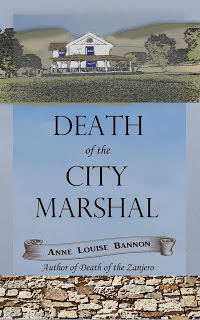
Anne Louise Bannon, Death of the City Marshal
(Robin Goodfellow, 2019)
I ran across this author on social media and purchased the first book in the series, Death of the Zanjero, out of curiosity. I don’t know too many books set in Los Angeles when it was still little more than a pueblo (ca. 1870—yes, California is young!), and the main character sounded interesting. I soon found myself rooting for the heroine—Maddie Wilcox, a widowed winemaker with medical skills. And I thoroughly enjoyed the twisty plot—which revolves around the murder of a water overseer (zanjero) whom almost everyone in town, including Maddie herself, has reason to want out of the way. In this second novel, the victim is Maddie’s self-appointed nemesis from the first book, so I can’t wait to find out what’s happened to him.
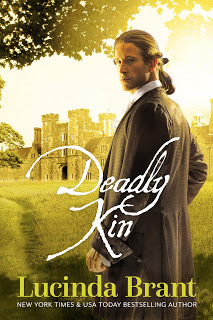
Lucinda Brant, Deadly Kin (Sprigleaf, 2019)
Another book acquired more or less by chance, through an Amazon recommendation. The time period—Georgian England, in this case not long before the American Revolution—hooked me, because it’s the era when my favorite Georgette Heyer novels take place. So I downloaded and read the first one, Deadly Engagement. The author really knows her stuff, and I was impressed both by her grasp of historical detail and her richly layered characters.
These books explore deep and often disturbing themes of eighteenth-century (and modern) family life: spousal abuse, infidelity, rape, incest, and the complicated effects of primogeniture and its absence, to name a few. That’s in addition to the usual motives of greed, revenge, and mental imbalance. I’m planning to interview the author for New Books in Historical Fiction in early summer, so stand by for more information when that podcast episode goes live.
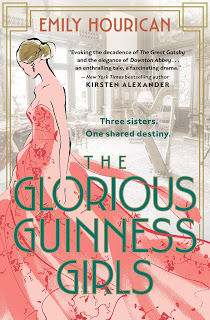
Emily Hourican, The Glorious Guinness Girls
(Grand Central Publishing, 2021)
This one came to me by way of a publicist, but because I was already booked for May and June, it’s been shifted to a written Q&A on this blog. The three daughters of Ernest Guiness (the beer guy), all blonde and blue-eyed, were a sensation in 1920s London society. Here Hourican explores their childhood and youth through the eyes of a fictional heroine—Felicity, known as Fliss—who is brought into the family at the age of ten. She experiences herself as somewhere between a charity case and an unpaid servant, but sharp and observant, she makes the perfect narrator for this tale of Anglo-Irish wealth, threatened by an emerging Catholic drive for independence, and the restlessness that drove the Roaring Twenties, a response to the devastation of the Great War.
Hourican, a former journalist and editor, has a keen appreciation of social and political conflict and a clear, compassionate writing style. Come back next month to see her answers to my questions.
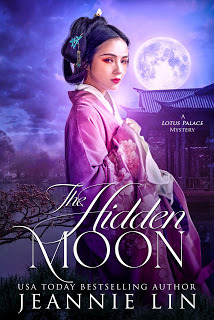
Jeannie Lin, The Hidden Moon (Jeannie Lin, 2020)
This self-published author hit the jackpot when one of the New York Times Book Review contributors picked her Jade Temptress for a historical fiction column. I read book 1, The Lotus Palace, and have almost finished The Jade Temptress (now snapped up by Harlequin). So I look forward to this one. Set in Tang Dynasty China (late ninth century), the series follows the adventures of two women, Yue-ying and Mingyu, who live in the Pingkang li, the notorious pleasure quarter of the then-capital of China, Changan. Mingyu, a high-ranking courtesan, falls under suspicion of murder in the first book; her maid, Yue-ying, and a handsome lord, Bai Huang, work together to solve the crime. They fall in love, but marriage is impossible because of the difference in their status and Lord Bai's prior contract. Or is it?
Despite her popularity and the wealth she earns, Mingyu cannot leave the quarter because she is owned by her “foster mother,” the woman who runs the Lotus Palace. In The Jade Temptress, Mingyu receives a summons to the house of her protector, where she finds him headless, so recently killed that the blood is still wet. Only the constable she detests from book 1 can help her clear her name.
This third novel features Bai Huang’s younger sister, Wei-wei, and a criminal associate of Lord Bai’s who, if the previous books are anything to go by, will almost certainly turn out to be more than he seems. But what I like about these novels is not the murders themselves, interesting and revealing of Tang Dynasty culture as they are, but the focus on women who, rich or poor, find ways to circumvent the many restrictions placed on them and achieve a measure of freedom.
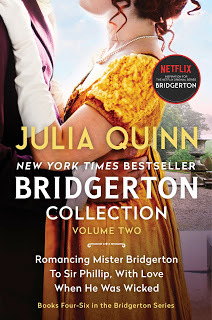
Julia Quinn, Bridgerton Collection, vol. 2 (Avon, 2021)
This one’s a bit of a cheat because, in effect, I cited it last time around. More accurately, I picked the first book in this collection, Romancing Mr. Bridgerton. But the two collections (books 4–6 and 7–8 plus a prequel) are now out, so if I’m to read them all and be ready for Miss Butterworth and the Mad Baron in July, I’d better get cracking!
March 26, 2021
Bringing Characters to Life
One of the most difficult tasks for any novelist, including myself, is to create characters who seem like real people: more noble, often, or more evil than the rest of us—depending on their role in the story—but neither wholly one nor completely the other and, most of all, distinct. Characters like that grow beyond an individual book and achieve a kind of immortality. Long after we have forgotten the plot details of Little Women or Anna Karenina or Vanity Fair, we remember Jo March and her saintly sister Beth, the doomed Anna and her faithless Vronsky, and Becky Sharp.
It’s true that after a while characters acquire a certain kind of life; they say and do things an author doesn’t expect. Such behavior offers insights into their being and makes a writer’s life easier. It’s also true that some characters arrive fully formed, with their own voices and traits, whereas others hide and require extensive coaxing to reveal their hidden selves, their goals.
But it’s also true that showing those developed characters from the very beginning of a novel is a task for the author, and no rewrite should be the last rewrite until that step has taken place. So how does that happen?
I’ll give you a favorite example of mine, one I go back to when wrestling with my own beginnings. It comes from Rhys Bowen’s Her Royal Spyness, and the person speaking is the heroine, Lady Georgiana Rannoch. Her very name hints at her character: although “Lady” has many shades of meaning in British society, it always refers to a noblewoman, and Rannoch is obviously Scots. The Lady First Name, especially for a woman, means a duke’s or perhaps an earl’s daughter; anyone lower is Lady Husband’s Last Name. But in the first line, we find out what it means specifically to Georgiana, known to friends and family as Georgie.
There are two disadvantages to being a minor royal.
First, one is expected to behave as befits a member of the royal family without being given the means to do so. [A list of royal tasks follows, one that will be familiar to anyone who has been following the latest flap among the Windsors over the departure of Prince Harry and Princess Meghan, followed by examples of the things royals cannot do, including applying for a job at Harrods as Georgie intends to do this very day.]
 When I venture to point out the unfairness of this, I am reminded of the second item on my list. Apparently the only acceptable destiny for a young female member of the house of Windsor is to marry into another of the houses that still seem to litter Europe.
When I venture to point out the unfairness of this, I am reminded of the second item on my list. Apparently the only acceptable destiny for a young female member of the house of Windsor is to marry into another of the houses that still seem to litter Europe.This opening excerpt reveals a surprising amount about what makes Georgie unique. We learn that she is royal, well educated, and quite proper (her use of “one,” for example) but aware of the contradictions in her world, willing to defy convention, and capable of questioning the strictures imposed on her in childhood. She also has a sharp tongue and a sense of humor, made even clearer on the next page, where she describes her grandmother as “the least attractive of Queen Victoria’s daughters,” an apparent burden that allowed Grandma to escape marriage to “a Romanov or a Kaiser, for which I am truly grateful and I expect she was too.”
We’re not two minutes into the story, but we already have Georgie’s quadruple-barreled name, insights into her heritage and approach to life, and most of all a clear sense of who she is. In a sense, as readers we’re already in love, ready to follow her wherever she wants to take us.
Here’s another example, one I encountered just recently while reading Deanna Raybourn’s A Curious Beginning, the first of a series set in late Victorian England starring Veronica Speedwell, the first-person narrator. Again, the first line is presented as action but actually reveals character: “I stared down at the open grave and wished that I could summon a tear.”
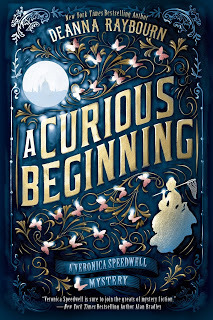 In the next line, we learn that Veronica is attending the funeral of Miss Nell Harbottle, “my guardian for the whole of my life,” yet she cannot cry and by the end of the paragraph is disconcerted by a sense of euphoria. “As if to match my mood, the breeze rose a little, and on it fluttered a pair of pale wings edged and spotted with black. ‘Pieris brassicae,’ I murmured to myself. A Large Garden White butterfly, common as grass, but pretty nonetheless.”
In the next line, we learn that Veronica is attending the funeral of Miss Nell Harbottle, “my guardian for the whole of my life,” yet she cannot cry and by the end of the paragraph is disconcerted by a sense of euphoria. “As if to match my mood, the breeze rose a little, and on it fluttered a pair of pale wings edged and spotted with black. ‘Pieris brassicae,’ I murmured to myself. A Large Garden White butterfly, common as grass, but pretty nonetheless.”You may think that Veronica is just cold, but that’s not the case. She notices butterflies because she has adopted lepidoptery as a profession—in an age where women did not, as a rule, have professions—and to her they symbolize freedom and beauty. Her failure to weep at her guardian’s grave reflects both the relationship between them, “tepid at best,” and a mystery about Veronica’s past that drives the novel and becomes clear only toward the end. Veronica is certainly unconventional, as her having a profession indicates, but she is also passionate about her convictions, enough to get her into a spat with the vicar’s wife within half an hour of the funeral. By the end of chapter 1, we know she has no interest in marriage, that she has had lovers (extraordinary for a young, single Victorian woman), that she treasures foreign adventure and intends to run her own life, and that she doesn’t give a hoot about either gossip or social censure.
Bowen and Raybourn, of course, are big-time authors with large followings—undoubtedly because of writing like this. But even self-published and small-press writers need to aim for the same standard. It’s not easy, but it can be done. At the risk of giving myself more credit than I deserve, here are two openings from my own novels, The Golden Lynx (2012) and Song of the Sisters (2021). The first is told in alternating third-person and the second from the perspective of a first-person narrator, but each book begins with its heroine.
Here is Nasan, the central character of The Golden Lynx and its entire series:
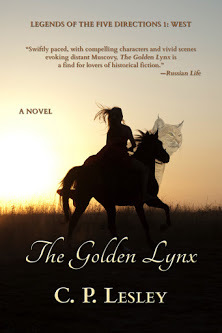 The lynx found Nasan just before the ambush. She glimpsed its tufted ears through the tangled branches of the birch tree, then lost sight of it when her brother launched his attack. Alerted by his joyous shriek, she jumped sideways and stuck out a foot, sending him somersaulting over the blizzard-kissed ground. She pelted him with snowballs, taunting him. “You forgot again, silly. How can you take me by surprise if you yell like that?”
The lynx found Nasan just before the ambush. She glimpsed its tufted ears through the tangled branches of the birch tree, then lost sight of it when her brother launched his attack. Alerted by his joyous shriek, she jumped sideways and stuck out a foot, sending him somersaulting over the blizzard-kissed ground. She pelted him with snowballs, taunting him. “You forgot again, silly. How can you take me by surprise if you yell like that?”And here is Darya, at first observing her older sister:
“Oh, Darya, you have to see this. A strutting peacock just entered our yard!” Solomonida stood on tiptoe, leaning forward until I worried she might tumble right through the open window in her eagerness. The late morning sunlight glinted off her jeweled headdress and found an answering glow in the wisps of blonde braid that had worked their way out from under the rim as she sewed.
“Peacock?” I stared at her and sighed. It wasn’t fair. My older sister was lovely, even at thirty-one. Not just beautiful, either, but vivid and charming—outgoing, outspoken, eager to interact with life beyond our courtyard gates. Next to her I felt like the quiet mouse she teasingly called me. “How would a peacock get into our yard?”
So what can we tell about these two women interacting with their siblings? Nasan is probably a teenager at most, since she still enjoys a snowball fight with her brother. She is active and competitive, and she takes no prisoners, pummeling her brother even when he’s down (we soon see him doing the same to her). Why the lynx is looking for her, we won’t find out for a while, but she notices it lurking, so she is at home in the forest and alert to its perils. Even so, we discover within a page or so that she is in fact courting danger, that she and her brother have defied their parents’ orders to stay within the fortress because of a threat that will sweep them into the story before they know it. So she is courageous and willing to buck authority—or simply young enough to believe in her own invincibility.
Darya, in contrast, views herself—and is viewed by others, so her perceptions are accurate—as a quiet mouse, inferior to her older sister (less pretty and charming), and shy about life outside her estate. She is perceptive and honest as well as observant, and she is not proud. If anything, she underestimates her own worth and defers too readily to others, including her sister. She has a developed aesthetic/artistic sense, describing Solomonida as a painter might. The jeweled headdress indicates that the family is noble, or at least wealthy—unlike Nasan, who at first glance could be anyone, although it soon becomes obvious that she’s at the very top of the social hierarchy, something that concerns her not at all. And the sisters have been sewing, a traditionally female occupation that brands them as fundamentally conventional even though as time goes by they will push at the boundaries of their world. It won’t surprise you, I’m sure, to learn that Nasan would rather do almost anything than ply a needle. Give her a sword and a horse any day.
See how much you can tell from a few sentences? It’s no accident that I use my characters over and over, once I’ve developed them. Finding them takes so much time, and getting them on the page requires an even greater investment. Keeping up with them as they grow is a challenge, too—maybe we'll talk about that another day—but nothing like as hard as getting to know them in the first place.
Even with all that, not everyone will create another Jo March or Becky Sharp. But it’s certainly worth a try.
March 19, 2021
Smith Women at War
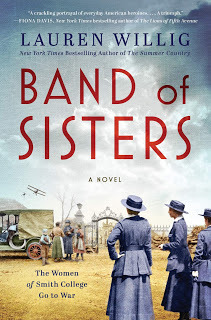 I’ve made no secret on this blog that I enjoy Lauren Willig’s writing. Whether it’s the fabulous eighteenth-century romp of her Pink Carnation novels, with their sly invocations of the works of Georgette Heyer (a long-time favorite of mine) as well as the more explicit references to Baroness Orczy’s The Scarlet Pimpernel, or stand-alones like The Summer Country, with its evocation of plantation slavery and its discontents in nineteenth-century Barbados, her books are a joy to read.
I’ve made no secret on this blog that I enjoy Lauren Willig’s writing. Whether it’s the fabulous eighteenth-century romp of her Pink Carnation novels, with their sly invocations of the works of Georgette Heyer (a long-time favorite of mine) as well as the more explicit references to Baroness Orczy’s The Scarlet Pimpernel, or stand-alones like The Summer Country, with its evocation of plantation slavery and its discontents in nineteenth-century Barbados, her books are a joy to read.Even so, I wasn’t quite sure what to expect from Band of Sisters, about the well-intentioned but challenging effort by a group of Seven Sisters alumnae to undo the damage wrought by the German invasion of northeastern France in World War I. Known as the Smith College Relief Unit, the real-life counterparts of Willig’s characters shipped across the Atlantic in 1917 and for the next two years fought everything from bureaucracy to gasoline shortages and shifting front lines to complete their mission: the restoration of French villages.
But again Willig takes this potentially grim story and finds a way to make it a page-turner. Over the course of the book, each woman in the unit—starting with its organizer, Mrs. Rutherford—emerges as a fascinating character in her own right. But as we discuss in my latest interview for New Books in Historical Fiction, the focus of the story is three interconnected members of the band: Kate Moran, an impoverished and reluctant teacher of French at a New York girls’ school; her college friend and roommate Emmie van Alden, burdened with the legacy of an exalted family heritage and a crusading but inattentive mother; and Emmie’s cousin Julia, a doctor whose self-confident and beautiful exterior hides a past she hesitates to share and a drive to succeed in her chosen profession that her family and even her medical colleagues do not support. Read on—and listen!—to find out more.
As usual, the rest of this post comes from New Books in Historical Fiction.
Kate Moran, a graduate of Smith College, has been making her living tutoring students in French when her college friend Emmie Van Alden appears out of the blue and talks Kate into joining a group of alumnae intent on offering relief to rural families in war-torn France. Despite her mother’s disapproval, in July 1917 Kate boards an ocean liner with the Smith College Relief Unit. She knows few of the other alumnae and dislikes some of those she remembers from her college days. Even her friendship with Emmie has been tarnished since graduation by their disparate family backgrounds.
After a dangerous journey across the Atlantic, where German U-boats still patrol the seas, the Smith women reach Paris. There they encounter one obstacle after another: incomplete paperwork, missing supplies, trucks delivered in pieces, absent members of their unit, and a simmering coup against their leader. Somehow they overcome their difficulties and reach their intended destination in Picardy, not far from the River Somme. But no sooner have they begun to make headway in their central mission—to restore farmlands and villages destroyed during the German invasion—than they hear of a renewed offensive that may undo all their hard work.
In Band of Sisters (William Morrow, 2021) Lauren Willig brings to life, with her signature flair, a little-known but riveting chapter in the history of World War I.
March 12, 2021
Interview with Deanna Raybourn
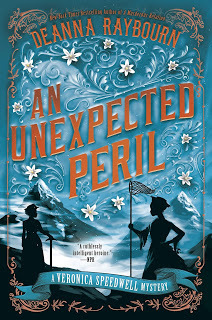 Years ago, I read a couple of Deanna Raybourn’s Lady Julia Grey novels. I had every intention of reading more, because they were great, but life got in the way and they joined the enormous and teetering To Be Read pile—which has only increased since I purchased a tablet to save my overstuffed bookshelves. Talk about well-laid plans that don’t come to fruition!
Years ago, I read a couple of Deanna Raybourn’s Lady Julia Grey novels. I had every intention of reading more, because they were great, but life got in the way and they joined the enormous and teetering To Be Read pile—which has only increased since I purchased a tablet to save my overstuffed bookshelves. Talk about well-laid plans that don’t come to fruition!But about a month ago, Raybourn’s publicist at Berkley wrote to alert me to the imminent appearance of An Unexpected Peril , no. 6 in a different series that hadn’t even crossed my radar. “Would I like to interview her for New Books in Historical Fiction?” was the question. The answer: yes, absolutely. But since I had no space in my schedule then, the three of us agreed to settle for this written Q&A now, with a podcast interview to follow next year when Veronica Speedwell no. 7 arrives. So read on for Deanna Raybourn’s responses to my queries, and then look for the books themselves. If you ever loved a novel about a strong-willed Victorian woman with a profession of her own and a yen for travel—Amelia Peabody, I’m looking at you!—Veronica and her partner, known as Stoker, are definitely for you.
Introduce us, please, to Veronica Speedwell. She is already on her sixth adventure. Where is she when her series starts with A Curious Beginning?
As A Curious Beginning opens, Veronica has returned home from her globe-trotting work as a butterfly hunter to attend the funeral of the woman who raised her. But that very afternoon, a stranger arrives to inform her that everything she thought she knew about herself is a lie and that her life is in peril. She accompanies him to London and embarks on a series of outrageous adventures as she ferrets out the truth of her own identity and solves a few murders along the way.
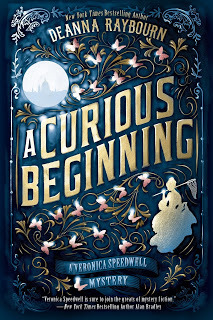 Early in that venture, she meets a man then known only as Stoker, who is charged with keeping her safe. What can you tell us about him?
Early in that venture, she meets a man then known only as Stoker, who is charged with keeping her safe. What can you tell us about him?Stoker is the rebellious younger son of an aristocrat—he is actually the Honourable Revelstoke Templeton-Vane. But he prefers to go simply by his nickname and for the world to take him on his own merits. He’s a former surgeon’s mate in Her Majesty’s Navy and is currently a natural historian with a specialty in preservation, especially taxidermy. He has earrings, tattoos, an eyepatch, and a nose for trouble.
By the time we get to An Unexpected Peril, Veronica and Stoker have already gone through a great deal together, including five murder investigations in little more than two years. How have these experiences changed them?
Both of them have been extremely wary of forming attachments with other people, and yet as time passes, they are assembling a found family, one of my favorite themes to write about. They are slowly learning to let other people in, a difficult thing for both of them because each has been badly hurt in the past. They also have work that intrigues them and the hobby of amateur detective work since they keep stumbling into murderous situations.
One important element of this novel is the Hippolyta Club, also called the Curiosity Club, where Veronica is a member. What do readers need to know about this institution?
The Hippolyta Club—known casually as the Curiosity Club—is an enclave for extraordinary women. I modeled it after a typical club for gentlemen of the time and populated it with women who are inspired by actual Victorian scientists, mathematicians, explorers, artists, poets, photographers, etc. Women of the period were often discouraged if not outright barred from different artistic and scientific disciplines, so having a club that not only permitted them but encouraged and celebrated their work seemed like a necessity. I think of it as a place where women could go and relax, challenge each other, debate, discuss, exchange resources and references. I suspect there are many secrets hidden within its walls.
At the opening of the novel, Alice Baker-Greene, another member of the Curiosity Club, has died. Veronica and Stoker are charged with arranging an exhibition memorializing Baker-Greene. What makes her memorable?
Alice Baker-Greene is inspired by two of the most famous Victorian mountaineers, Annie Smith Peck and Fanny Bullock Workman. They were very different women with different backgrounds and climbing styles and motivations, but they were outrageously determined. They were indefatigable and would summit with suffragist banners to draw attention to the cause they believed in. Alice Baker-Greene is exactly such a woman—ruthlessly ambitious in a way that would have been condoned in a man but is deplored in a woman. She is frank and forthright and afraid of nothing.
Baker-Greene, as we discover early on, died in the Alpenwald, a fictional principality in Europe that becomes central to the novel. The whole country is your creation, but why did you decide to create it—and having decided, how did you go about it?
I wanted a very memorable mountain for Alice to climb, and I could have used an existing peak, but where’s the fun in that? It was far more enjoyable to conjure my own tiny principality whose economy is based upon its single mammoth mountain and incredibly smelly cheese. There is also a political angle which made it necessary to create a sovereign state. Once I realized I was going to build a country from the ground up—literally—I decided to go all the way: language, architecture, flora, fauna, folklore. I loved every minute of creating the Alpenwald!
We’re scheduled to hold a New Books Network interview next year, when Veronica Speedwell #7 appears. Is that your next project, or do you have other novels underway as well?
I am writing Veronica #7 now and am also working on my first contemporary novel about a quartet of sixty-something female assassins who have to band together to take out the organization that wants them dead. Both should release in 2022, so it will be a busy year!
Thank you so much for answering my questions!
My pleasure—thanks!
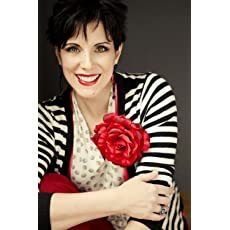
Deanna Raybourn is the award-winning New York Times bestselling author of the Lady Julia Grey series, currently in development for television, as well as the USA Today bestselling and Edgar Award nominated Veronica Speedwell Mysteries and several standalone works. Find out more about her at https://www.deannaraybourn.com.
March 5, 2021
Interview with G.P. Gottlieb
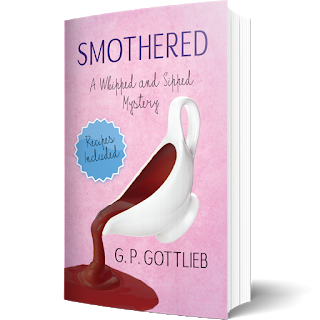 Last year, I interviewed G.P. Gottlieb, the host of New Books in Literature, about her debut novel,
Battered: A Whipped & Sipped Mystery
. You can hear that podcast conversation on the New Books Network.
Last year, I interviewed G.P. Gottlieb, the host of New Books in Literature, about her debut novel,
Battered: A Whipped & Sipped Mystery
. You can hear that podcast conversation on the New Books Network.
With the release of book 2, Smothered, we decided to go with a written Q&A instead. Mystery series are difficult to cover in depth, because basic setup in later books may give away crucial plot points in earlier ones. Those spoilers can be more easily avoided in the shorter format of a blog post.
But don’t be misled by the change of format. Smothered is, if anything, an even more compelling read than its predecessor—and not only because of the murder that lies at its heart. Alene Baron, the heroine, is not a professional detective; her life revolves around her café and her family at least as much as the hunt for a killer. So even if you prefer to read about delicious vegan recipes, this can be a novel for you.
This is the second of your Whipped & Sipped mysteries. People who’d like to know more about the first, Battered, can learn about it through your podcast interview with me on New Books in Literature. Why did you decide to center a mystery series on a café owner/chef?
To start with, I adore a good café! One of my favorite ways to meet friends (pre-pandemic, that is) is at one of the city’s many cafés for lunch or afternoon tea (with something delicious to nibble on, of course). Even more delightful when it’s a warm afternoon, and we can sit outside watching passersby. Who knows which of them might be planning a crime…
How would you describe Alene Baron, owner of the Whipped & Sipped Café, as a personality? What are her issues, and what pulls her into solving the mysteries you create for her?
Alene was a lot of fun to write about. She’s a solid citizen, always trying to help other people and concerned about family, friends, and community. She works long hours at the café, and then at home taking care of her father and children, so she’s a little wound up. She wishes she could be less suspicious and more kind-spirited, like her best friend, the pastry chef, but her suspicions draw her into solving the mystery.
Alene has a romantic relationship—still at a very early stage in Smothered—with Frank Shaw. What do we need to know about him?
Frank is a solid citizen. We won’t know more about his background until book 3 or 4 in the series, but we know that he’s divorced with two young adult children. Alene is falling in love: she’s been a single mother for eight years, and Frank is thoughtful, kind, and sweet-tempered. Plus her kids like him! Is it useful to know that he’s square-jawed, dark-haired, and has a dimple when he smiles?
Whipped & Sipped is a series of murder mysteries. Set up the crime in Smothered for us. What happens, and why does Alene get involved in solving it?
Alene’s neighbor, both at work and in her building, is an unpleasant character. Alene is outside in the alley when he’s found collapsed in his office and assumes that he died of a heart attack. When it becomes clear that he was murdered and one of Alene’s employees is unjustifiably considered as a prime suspect, she knows she has to get involved.
Without giving away spoilers, sketch some of the main suspects for us, including the reasons Alene includes them on her list.
Alene suspects one of the victim’s employees (who found the body), the victim’s son (who recently moved back to Chicago and is asking about his father’s will), the victim’s wife (a lonely, unloved hypochondriac who spends much of the book annoying people from her hospital bed), and the victim’s stepdaughter-in-law (who was once sexually assaulted by the victim). As is her custom, Alene also briefly suspects nearly everyone who crosses her path, but she quickly sets aside those suspicions.
One of the things I love about this series is that the stories are as much about Alene’s family and relationships with the people who work for her as they are about murders and suspects. For a heroine who is not a detective, this seems very realistic to me. What are the main non-crime-related problems that Alene faces in Smothered?
Alene worries about her children and is concerned about what her immature ex-husband is conveying to them. She’s saddened by her lack of a relationship with her younger sister, who scarcely finds time to visit their father when his autoimmune disease flares and he’s rushed to the hospital. She’s a concerned mama hen about the lives and life choices of some of her employees. She’s also worried about growing old alone, and cautiously hopeful about her budding relationship with Frank, the charming homicide detective.
This book has just come out. Are you already working on a third Whipped & Sipped mystery?
I am indeed! I’ve started a first draft of what I think will be Crushed: A Whipped and Sipped Mystery Book 3. When I begin writing a new novel, I like to write the story as if I’m telling it to myself. It’s filled with question marks and convoluted passages, winding paragraphs and indecipherable shorthand notes. I add bits and pieces every day, or I change my mind about who the murderer is, and why it happened. Then I think of that person’s backstory, and how he/she is connected to the café. And when I start thinking too much about recipes, I know it’s time to stop for lunch.
Thank you so much for answering my questions!
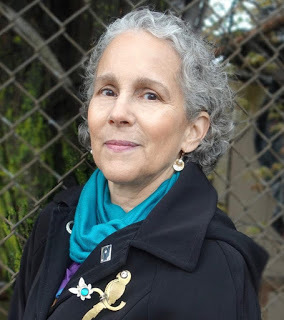 G.P. Gottlieb holds undergraduate and graduate degrees in piano and voice. Over the years, she performed, taught, composed, and administrated while writing stories, songs, and several unwieldy manuscripts. She also fed her family and developed lots of healthful recipes. After recovering from breast cancer, she turned to writing in earnest, melding her two loves, nourishment for mind and body and recipe-laced murder mysteries. She hosts New Books in Literature, a podcast channel on the New Books Network. Smothered is her second novel. Find out more about her and her books at http://www.gpgottlieb.com.
G.P. Gottlieb holds undergraduate and graduate degrees in piano and voice. Over the years, she performed, taught, composed, and administrated while writing stories, songs, and several unwieldy manuscripts. She also fed her family and developed lots of healthful recipes. After recovering from breast cancer, she turned to writing in earnest, melding her two loves, nourishment for mind and body and recipe-laced murder mysteries. She hosts New Books in Literature, a podcast channel on the New Books Network. Smothered is her second novel. Find out more about her and her books at http://www.gpgottlieb.com.



